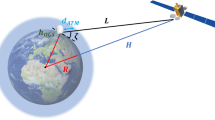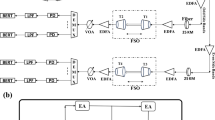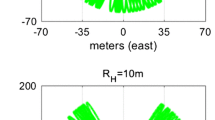Abstract
In this paper, optical feeder links to support high throuput satellite communication systems are studied. A methodology for the generation of the received irradiance/power time series for GEO optical feeder links (ground-to-GEO), that reproduces the long term irradiance/power statistics, is presented. In the proposed synthesizer, the atmospheric phenomena under clear sky that degrade the optical signal and the weak turbulence effects, i.e. scintillation, beam wandering and beam spreading, are considered. The proposed methodology takes advantage of the use of stochastic differential equations driven by fractional Brownian motion, for the time series synthesis. The methodology refers to the transmission of a single collimated beam. For the modelling of turbulence effects, Kolmogorov turbulence is assumed and the model is based on Rytov theory under weak fluctuations. Additionally, the proposed model is validated in terms of first order statistics with experimental data from the bi-directional optical GEO ARTEMIS satellite link experiment showing good agreement. Finally, the synthesizer is employed for the generation of fist order statistics for different transmission scenarios.






Similar content being viewed by others
References
Kaushal, H., & Kaddoum, G. (2016). Optical communication in space: Challenges and mitigation techniques. IEEE Communications Surveys and Tutorials, 99, 1.
Hemmati, H. (2009). Near-earth laser communications. Boca Raton: CRC Press.
Sodnik, Z., Furch, B., & Lutz, H. (2006). Free-space laser communication activities in Europe: SILEX and beyond. In LEOS 2006—19th annual meeting IEEE lasers and electro-optics society (pp. 78–79). IEEE.
Toyoshima, M., et al. (2008). Ground-to-satellite laser communication experiments. IEEE Aerospace and Electronic Systems Magazine, 23(8), 10–18.
Perlot, N., et al. (2007). Results of the optical downlink experiment KIODO from OICETS satellite to optical ground station Oberpfaffenhofen (OGS-OP). Proceedings of SPIE, 6457, 645704-1–645704-8.
Takenaka, H., et al. (2017). Towards a global quantum network. Nature Photonics, 11, 502–508.
Kolev, D., & Toyoshima, M. (2017). Satellite-to-ground optical communications using small optical transponder (SOTA): Received-power fluctuations. Optics Express, 25, 28319–28329.
Lyras, N. K., et al. (2017). Cloud attenuation statistics prediction from Ka-band to optical frequencies: integrated liquid water content field synthesizer. IEEE Transactions on Antennas and Propagation, 65(1), 319–328.
Lyras, N. K., Kourogiorgas, C. I., & Panagopoulos, A. D. (2017). Cloud free line of sight prediction modeling for optical satellite communication networks. IEEE Communications Letters, 21(7), 1537–1540.
Lyras, N. K., Efrem, C. N., Kourogiorgas, C. I., Panagopoulos, A. D., & Arapoglou, P. (2019). Optimizing the ground network of optical MEO satellite communication systems. IEEE Systems Journal. https://doi.org/10.1109/JSYST.2019.2945838
Lyras, N. K., Efrem, C. N., Kourogiorgas, C. I., & Panagopoulos, A. D. (2018). Optimum monthly based selection of ground stations for optical satellite networks. IEEE Communications Letters, 22(6), 1192–1195.
Fuchs, C., & Moll, F. (2015). Ground station network optimization for space-to ground optical communication links. IEEE/OSA Journal of Optical Communications and Networking, 7(12), 1148–1159.
Poulenard, S., Crosnier, M., & Rissons, A. (2015). Ground segment design for broadband geostationary satellite with optical feeder link. Journal of Optical Communications and Networking, 7, 325–336.
Dios, F., et al. (2004). Scintillation and beam-wander analysis in an optical ground station-satellite uplink. Applied Optics, 43(19), 3866.
Andrews, L., & Philips, R. (2005). Laser beam propagation through random media. Bellingham: SPIE Press.
Toyoshima, M., et al. (2005). Long-term statistics of laser beam propagation in an optical ground-to-geostationary satellite communications link. IEEE Transactions on Antennas and Propagation, 53(2), 842–850.
Reyes, M., et al. (2004). Ground-to-satellite bidirectional laser links for validation of atmospheric turbulence model. In Proceedings of the SPIE 5160, free-space laser communication and active laser illumination III (p. 44).
Arnon, S., et al. (2003). Performance limitation of laser satellite communication due to vibrations and atmospheric turbulence: Down-link scenario. International Journal of Satellite Communications and Networking, 21(6), 561–573.
Mustafa, A., et al. (2017). Quantifying the effect of atmospherically-induced pointing errors in optical geostationary satellite feeder links using transmitter diversity international conference on space optical systems and applications, ICSOS’2017, 14–16 November, Okinawa, Japan (pp. 1–6).
Alonso, A., Reyes, M., & Sodnik, Z. (2004). Performance of satellite-to ground communications link between ARTEMIS and the optical ground station. In Proceedings of the SPIE 5572, optics in atmospheric propagation and adaptive systems, VII (p. 372).
Comeron, A., et al. (2005). Modeling of power fluctuations induced by refractive turbulence in a multiple-beam ground-to-satellite optical uplink. In Proceedings of the SPIE 5892, free-space laser communications V (p. 58920).
Camboulives, A.-R., Velluet, M.-T., Poulenard, S., Saint-Antonin, L., & Michau, V. (2018). Statistical and temporal irradiance fluctuations modeling for a ground-to-geostationary satellite optical link. Applied Optics, 57, 709–721.
Toyoshima, M., et al. (2003). Optimum divergence angle of a Gaussian beam wave in the presence of random jitter in free-space laser communication systems. Journal of the Optical Society of America, 19, 567–571.
Mata, C. R., et al. (2014). Transmitter diversity verification on ARTEMIS geostationary satellite. In Proceedings of the SPIE 8971, free-space laser communication and atmospheric propagation XXVI (p. 897104).
Andrews, L. C., Phillips, R. L., Sasiela, R. J., & Parenti, R. R. (2006). Strehl ratio and scintillation theory for uplink Gaussian-beam waves: Beam wander effects. Optical Engineering, 45, 076001.
Shao, Y. (1995). The fractional Ornstein–Uhlenbeck process as a representation of homogeneous eulerian velocity turbulence. Physica D, 1995(83), 461–477.
Lyras, N. K., et al. (2018). Experimental optical satellite downlink irradiance statistics and turbulence conditions estimation. In IET conference proceedings (p. 903). EUCAP 2018 London.
Kanatas, A. G., & Panagopoulos, A. D. (2016). Radio wave propagation and channel modeling for earth-space systems. Boca Raton: CRC Press.
Acknowledgements
The work presented in this paper was carried out under the project ONSET (ESA Contract No. 40000113462/15/NL/NDe). ONSET was funded by the Government of Luxembourg (Ministry of Economy) through an ESA Contract in the Luxembourg Third Party Programme, for which Prime Contractor was SES TechCom S.A. The views expressed herein can in no way be taken to reflect the official opinion of the European Space Agency (ESA).
Author information
Authors and Affiliations
Corresponding author
Additional information
Publisher's Note
Springer Nature remains neutral with regard to jurisdictional claims in published maps and institutional affiliations.
Appendix
Appendix
More information about the use of Stochastic Differential Equations (SDE) driven by fractional Brownian Motion for the generation of a zero-mean unity-variance Gaussian process with a power spectral density of low-pass shape are reported in this “Appendix”. The underlined Gaussian process is generated through [26]:
Since for a given variance, \({\chi _{t}}\) can be considered as a Gaussian process with zero mean value, the Langevin equation with fBm (fractional Langevin equation) is used for modeling the time series of log-amplitude, given that the variance equals to 1, \({\chi _{t,1}}\):
The solution of the above equation with zero initial value is:
The above process is called fractional Ornstein-Uhlenbeck process and it is a Gaussian process with zero mean value and the co-variance of \({\chi _{t}}\), \({\chi _{t,s}}\) is [26]:
H is Hurst index.
Therefore, the variance of the Ornstein-Uhlenbeck process is:
Since, firstly we want to have a unitary variance process we set:
For the energy spectrum of fractional Ornstein-Uhlenbeck process holds that [26]:
where \({{F_{{\omega _b}}}(f)}\) is the energy spectrum of fractional Gaussian noise and it holds that:
From (16) and (17), it holds for high frequencies that:
with corner frequency:
The corner frequency can be modeled from the temporal spectrum of turbulence.
To sum up, the main steps of the methodology are summarized. To begin with, taking into account the the slope of the power spectral density, the Hurst index is calculated using Eq. (27). Then, \(\lambda _s\) parameter is computed from the corner frequency according to Eq. (28) and the parameter \(\sigma\) is computed from Eq. (24). Finally, employing Eq. (21) time series are generated.
Rights and permissions
About this article
Cite this article
Lyras, N.K., Kourogiorgas, C.I., Panagopoulos, A.D. et al. Long Term Irradiance Statistics for Optical GEO Satellite Feeder Links: Validation Against Experimental Data. Wireless Pers Commun 114, 749–764 (2020). https://doi.org/10.1007/s11277-020-07391-2
Published:
Issue Date:
DOI: https://doi.org/10.1007/s11277-020-07391-2




